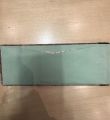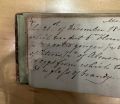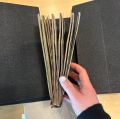Recipe Book: Ms. Codex 2142
This manuscript is a recipe book written in England circa 1815-1831. The first pages of the manuscript contain a copy of British artist and art teacher William Fleetwood Varley’s “A few observations on art with notices relative to the various exhibitions, repositories of art, etc.” (p. i-xxi), while the rest of the book comprises a collection of one hundred and forty-four remedial, household, and culinary recipes written in both English and French. Some recipes include lemon cheesecake, pig’s feet jelly, tea cakes, mock turtle soup, and how to wash and clean gentleman's gloves. The book was formerly owned by James Stevens Cox (1910-1997), a fellow of the Society of Antiquarians. It was sold by Forum Auctions in 2020 and was acquired by the University of Pennsylvania with the help of the Edgar Fahs Smith Memorial Fund. The book currently resides in University of Pennsylvania’s Kislak Center for Special Collections under the identifier “Ms. Codex 2142.” It is not copyrighted.
Background
Definitions
Receipt books, also known as recipe books or cookbooks, are guides of how to make domestic creations. Though today such books predominantly convey information about how to prepare food, when recipe books first circulated among housewives in the sixteenth century, this was not strictly the case. Whether manuscript, or later, printed, receipts offered instructions on how to prepare meals, beverages, medications, cosmetics, household products, lotions, toothpastes, wines, perfumes, paints, inks, and other ingredient-based creations. Receipts did not always explicitly state the exact list of ingredients needed or quantities yielded after preparation.
Historical Context
Given that this manuscript was composed in early nineteenth century England, it exists as part of a rich history of recipe book production. From 1575-1650, England reigned as the most prominent place of cookery publication in Europe. During this period, men wrote recipe books in order to disseminate their elite knowledge on how to transform festive dishes for noble feasts into everyday meals, as well as how to create potions capable of curing various illnesses. Unlike the case in other countries in the region, these books were marketed to affluent women, offering them the opportunity to oversee a wide range of household-knowledge based skills called “housewifery,” which included food preservation, water purification, textile production, and the cultivation of medical remedies.
With new domestic responsibilities, women learned to prepare surprise dinners, create practical and stylish beauty products, and write their own food-poems. They also played with ingredients in order to make culinary dupes, such as manipulating sugar paste and natural dyes in order to prepare faux bacon and eggs. Interestingly, since both recipes for food and medicine were kept together in such books, many recipes explored the health benefits of different dishes. For example, a recipe for strawberry jam might be included not simply for its delicious taste, but because eating it could help alleviate temporary and permanent ailments, such as an ague or hot liver.
Though initially read by an elite group of literate women, as literacy rates increased across classes during the seventeenth century, cookbooks reached women on lower rungs of the social ladder, like servant’s wives. Even more, in the eighteenth century, housekeepers and mistresses became the target audience of recipe books. By the mid-eighteenth century, recipe books evolved to focus less on food's medicinal properties, and instead, prioritized cuisine. They also moved away from citing the sources of their recipes and filled this space instead with descriptions of their practical expertise. It is within this evolutionary shift of the cookbook that Ms. Codex 2142 came into existence.
Material Analysis
Substrate
On the front pastedown of this book, there is a pocket, highlighting that such books could be used as a form of storage. In this pocket, the author included a few additional loose recipes, such as ones about what to put in flower vases in the winter, recipes for lemonade, and recipes for lemon cheesecakes. The paper on the pastedown and fly leaves are a light green, while the paper used for the rest of the book is a light brown. On this brown paper, we can see the chain lines formed from when the paper was made, and on the green paper, we can also see the chain lines as well as faint horizontal lines, which might have come as a result of the wires used to make this paper as well.
-
Inside pocket on the front pastedown of the book
-
Lemon Cheesecakes recipe insert
-
Illustration of different colored paper and chain lines
Format and Binding
This object is an oblong shaped codex. The book’s dimensions are 8 x 21 cm, so it is much longer horizontally than it is vertically. As this manuscript was originally a blank notebook, the book itself could have been made by the household, or it could have been bought from a stationer. The shape of this book lends itself well to hand carrying, easily able to fit into the pockets of women’s dress’ so that they could write down new receipts as they stumble upon them. On the spine of this book, we can see that it is composed of four gatherings, with 26 leaves per gathering. This book is bound in quarter leather, and the covers seem to be made out of pasteboard. The binding appears to be the original one, as there is not an excess of flyleaves or other indications that it might have been re-bound.
-
Illustration of oblong shape
-
Illustration of binding
Interestingly, the handwriting of the pagination of the book in the first 15 pages is different from that of the rest of the book. According to Franklin Library’s metadata, it is clear that the creator of the text wrote in the page numbers from p. 1-14, while the cataloger supplied the rest (p. i-xxi, 15-160). Additionally, on the bottom of the pastedown, there seems to be a shelfmark written in pencil; it reads “Ms. Codex 2142,” which lines up with the current call number in Franklin’s catalog, indicating that this library identifier might have been written relatively recently.
Aside from these more formal navigation cues, each recipe in this book contains a header about what recipe it is, like whether it is a recipe for how to prepare an “Elixir for the Toothache” or “A Rich Cake.” Each recipe is not necessarily on its own page, as the author might include two recipes on one page in order to avoid wasting space. In these cases, the recipes might be separated by a line or merely by a new header. This manuscript also does not seem to be organized so that medical recipes are separated from ordinary food recipes and does not always include exact measurements needed to prepare a given recipe.
Paratexts
In the beginning of this book, there is a preface which begins the creator’s handwritten copy of William Fleetwood Varley’s “A few observations on art with notices relative to the various exhibitions, repositories of art, etc.” (p. i-xxi). This copy includes recipes for different colored ink, offering instructions on how to prepare purple grays and warm greens. Given that this copy is written on the first pages of this manuscript, it is possible that this manuscript began as a book about art techniques and was later adapted into a recipe book. The fact that a book containing Varley's observations could be easily repurposed as a recipe book speaks to the way that recipe books at this time were not limited to food, but rather served as encompassing guides on how to prepare anything that might be useful in the domestic realm. For instance, given this creator’s interest in Varley’s work, she might have been an aspiring artist and would have needed these recipes for ink in order to exercise her artistic abilities in her free time.
Additionally, throughout this copy the creator of this book seems to have listed the name of the person from whom she learned a given recipe in order to give them credit for it. For example, on page 77, the creator attributes a beef recipe to a woman named Elizabeth Elley.
Marginalia and Marks
This book has been entirely written by its creator, with the exception of the cataloguer’s pagination and shelfmark. The creator’s handwriting, though beautiful, is also hard to read, and begins to get sloppy when she tries to squeeze in a word on the page, perhaps demonstrating that this copy was mostly used for personal use.
On page 157, there is a pencil drawing of a person in the middle of a recipe. Given the creator’s interest in art, this is not surprising, as she might have flipped to a blank page to doodle, and then later needed to use that page to write down a new recipe. Other than this doodle, there do not seem to be any more annotations.
Significance
This manuscript recipe book is significant as a historical example of a receipt book, shedding light onto the way that recipes were communicated and documented in the late eighteenth to early nineteenth centuries. The recipes themselves offer insight into the kinds of meals the English prepared, medical remedies used to heal the sick, and household products needed to keep a clean home during this period. As such, while these recipes might appear so mundane they might not be worth saving, it is important to recognize that these everyday documents provide historians today with a cultural archive of the past. Additionally, given that these books were mostly made by and for women, recipe books offer a glimpse into the lives and domestic roles of women at this time. Such personal, manuscript, female-authored documents also enable historians to access the largely overlooked lives of these women, as these recipes often serve as their only legacy. As a result, these recipes are not only significant for their insights into the objects used at the time, but they also provide important documentations of identity, family traditions, and instances of female creativity as they took agency over their domestic roles.




